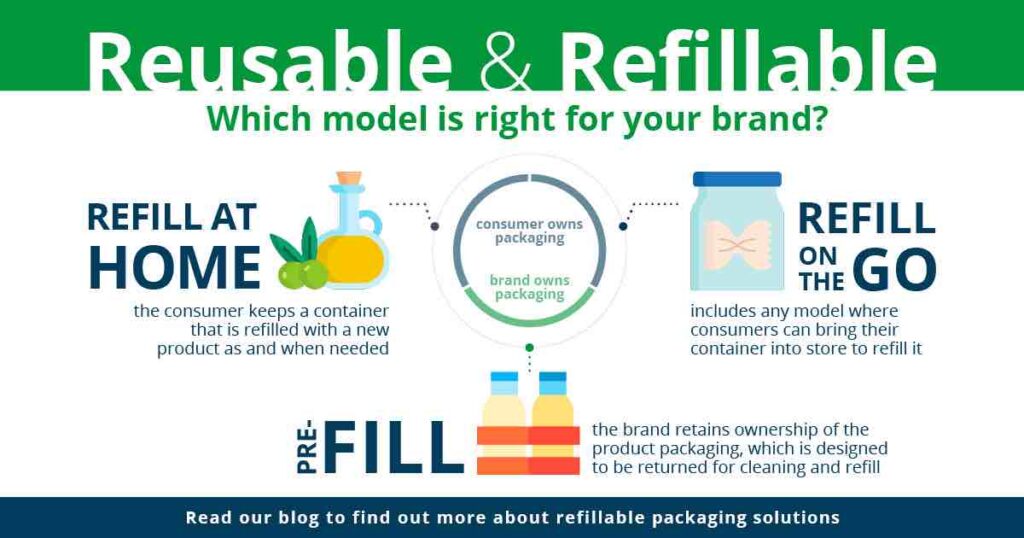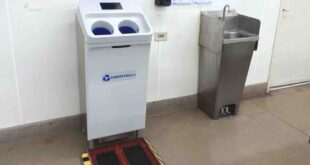Adopting a reusable packaging model requires careful consideration. As with any new packaging solution, choosing the most appropriate packaging and associated product labelling system for individual products is essential. Brands should work with their coding and marking suppliers to identify the optimal solution for their specific requirements. Lee Metters explores the topic further
In recent years, governments worldwide have emphasised the need to shift towards a circular economy for packaging, with a particular focus on phasing out single-use, virgin, and unrecyclable plastics and exploring options for reusable products and refillable packaging.
Many brands have also established ambitious commitments to make their packaging more sustainable by 2025. More than 500 organisations have signed up for the Ellen MacArthur Foundation’s New Plastics Economy Global Commitment, which recognises that reuse models should be explored to reduce the need for single-use plastic packaging.
However, while the drivers for adopting refill and reuse models are clear, the fundamentals of implementing such packaging solutions, while ensuring regulatory compliance, connecting with consumers, and gathering data for business insight are not necessarily straightforward. Particularly in coding and marking, different models may require different approaches to product labelling.

Opportunities for brands exploring refill and reuse models
The Ellen MacArthur Foundation suggests that, globally, replacing just 20% of single-use plastic packaging with reusable alternatives offers an opportunity worth at least USD 10 billion.
The benefits include the obvious cost reductions associated with reduced packaging and transportation yet reuse and refill models can also help to improve the overall consumer experience, build brand loyalty, and generate valuable data and insight to help inform business decisions.
However, the various consumer-facing reuse and refill models will present different options and opportunities for brands and demand different product labelling information and methods.
Refill-at-home
With a refill-at-home model, the consumer keeps a container that is refilled with a new product as and when needed. Refill-at-home is typically suited to the soft beverage and home and personal care sectors. Examples include bulk buy and standard-size refill pouches, and compact size refills, including pods, tablets, and concentrates, which can be diluted with water at home.
Refill-at-home models can work for both online and traditional brick-and-mortar retail – though there are significant benefits for brands operating in the ecommerce space. When unrestrained by shelf space, brands can take the opportunity to provide more options and greater customisation for customers and can offer products as part of a subscription service to build brand loyalty and encourage repeat sales.
Refill packs will be subject to the same coding and marking requirements as traditional consumer products – though with compact size refills, the code may need to be printed at a fraction of the size of the original packaging. Brands exploring refill-at-home models could consider utilising 2D codes, such as QR codes. 2D codes could provide further information to consumers, including instructions for use or refill or personalised waste reduction statistics.
Refill-on-the-go
Refill-on-the-go solutions include any model where consumers can bring their container into store to refill it – this includes in-store dispensing platforms and packaging-free ‘buy by weight’ retailers.
Refill-on-the-go models can be used for fast-moving consumer goods – from food and beverage to home and personal care. The model can accommodate customers’ needs by providing the option to ‘only buy what you need’, helping to avoid product waste.
As with concentrates, refill-on-the-go solutions can help tap into consumers’ desire for greater personalisation – offering a practical option for consumers to ‘pick and mix’ their ideal combination of flavours. In addition, brands can use refill-on-the-go to gather user insight through dispensing systems that recognise the user and collect data on preferences.
Refill-on-the-go solutions may also be subject to coding and marking requirements – for example, allergen labelling for food and beverage products. This requirement can best be achieved using a printed label applied to the packaging after filling. Brands could use these labels to provide an additional touchpoint with consumers after they leave the store or dispenser – for example, with consumer-facing QR codes, for promotions, or loyalty schemes.
Some refill-on-the-go models may necessitate having a consumer buy an initial container which is designed for reuse. Brands that create their own refillable packaging can utilise permanent coding, such as that afforded by laser coders to create container tracking marks. These can be used to ensure that containers are refilled with the correct products and to deliver pre-measured quantities of products to avoid overfilling, which could damage pack integrity or appearance.
Pre-fill
With a pre-fill model, the brand retains ownership of the product packaging, which is designed to be returned for cleaning and refill. Pre-fill models include traditional retail, also known as ‘return on the go’; and e-commerce solutions which are known as ‘return from home’. In both systems, consumers will typically be charged a refundable deposit to cover the cost of the packaging, which are returned to the brand for cleaning and refill.
Pre-fill models have long been used in the brewery sector, and the dairy industry, via traditional milkman delivery services and local supermarkets. More recently, platforms such as Loop, and Return, Refill, Repeat from Beauty Kitchen, have attempted to bring the pre-fill revolution to brands in more industries.
When considering the coding and marking of pre-fill products, there are multiple solutions for brands looking to meet regulatory requirements, connect with consumers, and gather valuable business insight.
Specific codes, such as best before and use by dates, and batch codes, will need to last the entire shelf-life of the packaging and be removed once the product is returned for cleaning and reuse. Potential solutions include stick-on labels, which can be removed once a piece of packaging is returned, or removable inks, which can be removed as part of the final washing process.
Permanent coding solutions – such as those offered by laser coders – also have a role to play here. Brands can use permanent, unique 2D codes to facilitate customer returns, track items throughout their lifecycle, and gather insight on consumer preferences. As the information within 2D codes can be updated, a permanent code could also include batch-specific data, including allergens and use by dates. The same codes can also be used as additional touchpoints with consumers to build further brand engagement.
Tips for brands exploring reuse and sustainable packaging
1. Choose the best model for your business
There is no ‘one size fits all’ solution for sustainable packaging. The ideal solution will vary depending on your sector, products, supply chain capabilities, and standard retail outlets. Identify where you can have the most impact and pick the most suitable model for your business.
Suppose you can’t identify a refill and reuse model which suits your business. In that case, there are other sustainable packaging solutions to consider, including recycled metal and plastic, and compostable alternatives.
2. Make it simple and affordable
Consumers are willing – but they also crave convenience. The ease of single-use packaging is a huge barrier to widespread refill adoption. Any model needs to be developed with the end consumer in mind to make purchasing, refilling, and returning or recycling as easy as possible. It’s also important to consider pricing and ensure that deposits and initial start-up purchases are competitively priced.
3. Use coding and marking to enrich the consumer experience
Consumer-facing variable 2D codes, such as QR codes, can profoundly benefit brands exploring refill and reuse. Consider linking to a brand-specific app to allow consumers to track purchases, refills, and packaging saved, or provide personalised nutritional information, product suggestions, and loyalty rewards. The same codes can encourage social sharing and reviews or direct users to additional information such as refill and reuse instructions.
Conclusion
Adopting a reusable packaging model requires careful consideration. As with any new packaging solution, choosing the most appropriate packaging and associated product labelling system for individual products is essential. Brands should work with their coding and marking suppliers to identify the optimal solution for their specific requirements. As more brands explore alternative packaging solutions, collaboration with suppliers and manufacturing partners will be key to creating products that will be accepted by retailers, trusted by consumers, and valued by everyone with an environmental concern.
Lee Metters is Group Business Development Director of Domino Printing Sciences.
 Engineer News Network The ultimate online news and information resource for today’s engineer
Engineer News Network The ultimate online news and information resource for today’s engineer



